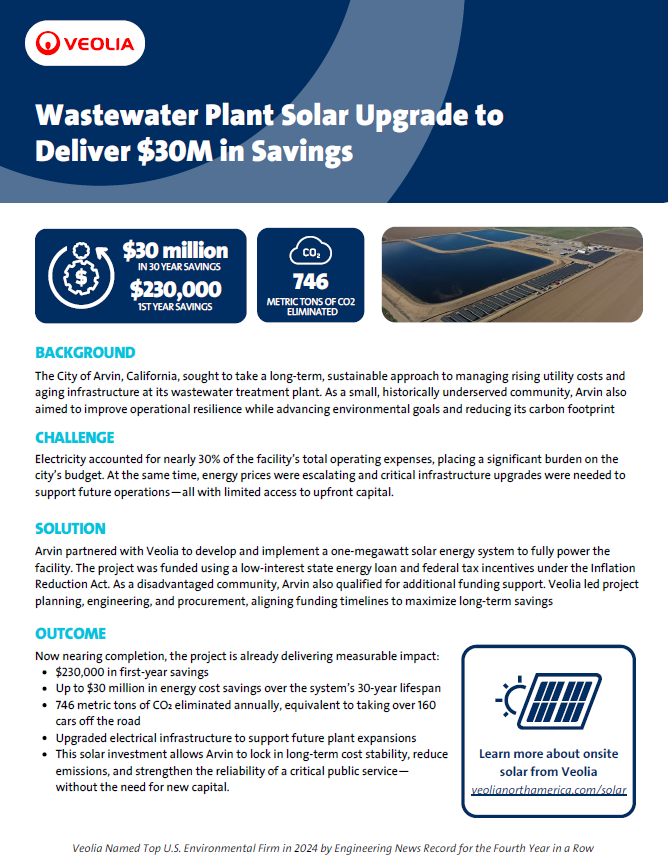Municipalities face growing pressure to manage their resources effectively, and energy costs at wastewater treatment plants (WWTPs) are among the largest expenses. These facilities can account for up to 40% of a municipality’s total energy use. In high-cost electricity states like California, New York and Massachusetts, energy bills for a single large WWTP can exceed $6 million annually.
As electricity prices continue to rise and fluctuate, delaying energy-saving investments at WWTPs can lead to tens of millions of dollars in avoidable costs. In this blog, you’ll learn how rising energy costs impact WWTP budgets over time, how energy use differs by plant size and which strategies — including efficiency upgrades, on-site renewables, and smart energy procurement — can deliver major long-term savings. We’ll also explore funding options that make it possible to implement these solutions without adding financial burden today.
What Defines Small, Medium and Large WWTPs?
WWTPs vary in size and energy consumption:
- Small WWTPs: Serve fewer than 50,000 people and consume 5 million to 15 million kilowatt-hours (kWh) annually.
- Medium WWTPs: Serve between 50,000 to 100,000 people and consume 15 million to 30 million kWh annually.
- Large WWTPs: Serve over 100,000 people and consume 30 million to 60 million kWh annually.
For this analysis, we use benchmark figures reflecting typical energy use and rates in high-cost states.

The Cost of Inaction: Rising Energy Prices and Budget Impact
Electricity prices are unpredictable, but a 3% annual increase is a conservative estimate based on historical trends. Costs for capacity, transmission and regulatory charges often rise faster than market electricity prices.
The below chart outlines the projected energy cost escalation for a large WWTP over a 30 year period, assuming an electricity rate range of $0.20 to $0.30 per kWh, reflecting high to very high-cost regions. The total additional energy cost over 30 years equals $54 million to $81 million.
Without action, municipalities could see annual energy costs more than double, straining public budgets.
|
Year |
Electricity Rate (per kWh) |
Annual Energy Cost (Millions) |
|
2025 |
$0.20 - $0.30 |
$6.0 - $9.0 |
|
2035 |
$0.26 - $0.39 |
$7.8 - $11.7 |
|
2045 |
$0.36 - $0.54 |
$10.7 - $16.1 |
|
2055 |
$0.44 - $0.66 |
$13.2 - $19.8 |
The Opportunity: How Energy Efficiency and Renewables Deliver Big Savings
Municipalities can reduce costs and risk through three key strategies:
1. Energy Efficiency Projects
Efficiency upgrades such as LED lighting, HVAC optimization, control systems and high-efficiency pumps can cut energy use by 10% to 35%.
Estimated 30-year savings:
- Small WWTPs: $8M - $15M
- Medium WWTPs: $12M - $25M
- Large WWTPs: $18M - $36M
2. Renewable Energy & On-Site Generation
On-site generation solutions can significantly lower energy costs while improving grid independence. WWTPs can leverage:
- Solar Photovoltaics (PV) and battery storage to reduce peak energy demand and increase reliability.
- Wind Power, where feasible, to generate clean electricity and offset grid purchases.
- Digester Gas (biogas) recovery, using methane produced in wastewater treatment to generate onsite electricity and heat.
- Microgrids, combining multiple generation sources for energy resilience and cost control.
Estimated 30-year savings:
- Small WWTPs: $12M - $18M
- Medium WWTPs: $20M - $30M
- Large WWTPs: $28M - $40M
3. Commodity Procurement & Risk Management
Strategies like power purchase agreements (PPAs), hedging and risk management contracts stabilize energy costs and reduce volatility.
Estimated 30-year savings:
- Small WWTPs: $5M - $10M
- Medium WWTPs: $8M - $15M
- Large WWTPs: $12M - $20M
Combining energy efficiency upgrades, on-site renewable generation, and strategic commodity procurement yields tremendous compounding savings over 30 years — exceeding $30 million for small WWTPs, $50 million for medium facilities, and $80 million for large plants. This transformational scale of savings significantly bolsters long-term financial resilience.

Conclusion: The Financial Case for Acting Now
For WWTPs of all sizes, delaying energy-saving investments could result in millions of dollars in avoidable costs over 30 years. Even with uncertainties in energy pricing and regulations, the risk of inaction is clear: higher bills, budget strain and lost reinvestment opportunities.
By acting now, municipalities can:
- Control long-term costs through efficiency, renewables and procurement strategies.
- Future-proof operations against rising electricity prices and regulatory changes.
- Demonstrate fiscal and environmental leadership.
Financing Solutions
Municipalities have multiple funding options for energy projects:
- Federal Grants and Incentives: Assistance in securing funding.
- Guaranteed Energy Savings Performance Contracts (ESPCs): Projects funded by guaranteed savings.
- Power Purchase Agreements (PPAs): Third-party ownership of energy assets with long-term cost savings.
- Energy-as-a-Service (EaaS): No upfront capital investment; private partners own and operate infrastructure.
- Turnkey Solutions: Full-service program and project delivery, from concept to post-operation monitoring.
By leveraging these funding mechanisms, municipalities can implement cost-saving projects without burdening their budgets, securing long-term savings while improving resilience.



